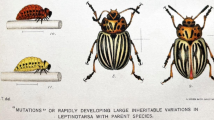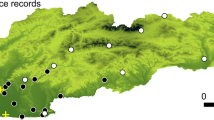Abstract
We reared large (1000 individuals) and small (20 individuals) populations of Tribolium castaneum on diet contaminated with copper in order to determine if the size of a population affects its ability to adapt to adverse environmental conditions. After 10 generations, we used microsatellite markers to estimate and subsequently compare the genetic variability of the copper-treated populations with that of the control populations, which were reared on uncontaminated medium. Additionally, we conducted a full cross-factorial experiment which evaluated the effects of 10 generations of “pre-exposure” to copper on a population’s fitness in control and copper-contaminated environments. In order to distinguish results potentially arising from genetic adaptation from those due to non-genetic effects associated to parental exposure to copper, we subjected also F11 generation, originating from parents not exposed to copper, to the same cross-factorial experiment. The effects of long-term exposure to copper depended on population size: the growth rates of small populations that were pre-exposed to copper were inhibited compared to those of small populations reared in uncontaminated environments. Large Cu-exposed populations had a higher growth rate in the F10 generation compared to the control groups, while the growth rate of the F11 generation was unaffected by copper exposure history. The only factor that had a significant effect on genetic variability was population size, but this was to be expected given the large difference in the number of individuals between large and small populations. Neither copper contamination nor its interaction with population size affected the number of microsatellite alleles retained in the F10 generation.




Similar content being viewed by others
References
Bickham JW, Sandhu S, Hebert PDN, Chikhi L, Athwal R (2000) Effects of chemical contaminants on genetic diversity in natural populations: implications for biomonitoring and ecotoxicology. Mutat Res-Rev Mutat 463:33–51
Bradshaw AD (1952) Populations of Agrostis tenuis resistant to lead and zinc poisoning. Nature 169:1098
Brown JW, Coeverden Van, de Groot PJ, Birt TP, Seutin G, Boag PT, Friesen VL (2007) Appraisal of the consequences of the DDT-induced bottleneck on the level and geographic distribution of neutral genetic variation in Canadian peregrine falcons, Falco peregrinus. Mol Ecol 16:327–343
Chapuis MP, Estoup A (2007) Microsatellite null alleles and estimation of population differentiation. Mol Biol Evol 24:621–631
Charlesworth D, Willis JH (2009) The genetics of inbreeding depression. Nat Rev Gen 10:783–796
Chen XY, Li N, Shen L, Li YY (2003) Genetic structure along a gaseous organic pollution gradient: a case study with Poa annua L. Environ Pollut 124:449–455
Demuth JP, Drury DW, Peters ML, Van Dyken D, Priest NK, Wade MJ (2007) Genome-wide survey of Tribolium castaneum microsatellites and description of 509 polymorphic markers. Mol Ecol Notes 7:1189–1195
Fisker KV, Sørensen JG, Damgaard C, Pedersen KL, Holmstrup M (2011) Genetic adaptation of earthworms to copper pollution: is adaptation associated with fitness costs in Dendrobaena octaedra? Ecotoxicology 20:563–573
Fox CW, Reed DH (2011) Inbreeding depression increases with environmental stress: an experimental study and meta-analysis. Evolution 65:246–258
Frankham R (2005a) Genetics and extinction. Biol Conserv 126:131–140
Frankham R (2005b) Stress and adaptation in conservation genetics. J Evol Biol 18:750–755
Frankham R, Ballou JD, David A, Briscoe DA (2010) Introduction to conservation genetics, 2nd edn. Cambridge University Press, Cambridge
Gilpin ME, Soulé ME (1986) Minimum viable populations: Processes of species extinction. In: Soulé ME (ed) Conservation Biology: The Science of Scarcity and Diversity. Sunderland, Sinauer & Associates, pp 19–34
Goudet J (2001) FSTAT, version 2.9.3, a program to estimate and test gene diversities and fixation indices. www2.unil.ch/popgen/softwares/fstat.htm
Grant A (1998) Population consequences of chronic toxicity: incorporating density dependence into the analysis of life table response experiments. Ecol Model 105:325–335
Gui Y, Grant A (2008) Joint effects of density dependence and toxicant exposure on Drosophila melanogaster populations. Ecotoxicol Environ Saf 70:236–243
Hedrick PW (1994) Purging inbreeding depression and the probability of extinction: full-sib mating. Heredity 73:363–372
Kim SJ, Rodriguez-Lanetty M, Suh JH, Song JI (2003) Emergent effects of heavy metal pollution at a population level: Littorina brevicula as a study case. Mar Pollut Bull 46:74–80
Krane DE, Sternberg DC, Burton GA (1999) Randomly amplified polymorphic DNA profile-based measures of genetic diversity in crayfish correlated with environmental impacts. Environ Toxicol Chem 18:504–508
Murdoch MH, Hebert PDM (1994) Mitochondrial L-DNA diversity of brown bullhead from contaminated and relatively pristine sites in the great-lakes. Environ Toxicol Chem 13:1281–1289
Nadig SG, Lee KL, Adams SM (1998) Evaluating alterations of genetic diversity in sunfish populations exposed to contaminants using RAPD assay. Aquat Toxicol 43:163–178
Nowak C, Vogt C, Pfenninger M, Schwenk K, Oehlmann J, Streit B (2009) Rapid genetic erosion in pollutant-exposed experimental chironomid populations. Environ Pollut 157:881–886
Posthuma L, van Straalen NM (1993) Heavy-metal adaptation in terrestrial invertebrates: A review of occurrence, genetics, physiology and ecological consequences. Comp Biochem Phys C 106:11–38
Radwan J (2003) Inbreeding depression in fecundity and inbred line extinction in the bulb mite, Rhizoglyphus robini. Heredity 90:371–376
Schuelke M (2000) An economic method for the fluorescent labelling of PCR fragments. Nat Biotechnol 18:233–234
Sibly R, Calow P (1989) A life-cycle theory of responses to stress. Biol J Linn Soc 37:101–116
Van Straalen NM, Timmermans M (2002) Genetic variation in toxicant-stressed populations: An evaluation of the ‘‘genetic erosion’’ hypothesis. Hum Ecol Risk Assess 8:983–1002
Wolf JB, Wade MJ (2009) What are maternal effects (and what are they not)? Philos Trans R Soc B 364:1107–1115
Woods R, Hoffmann A (2000) Evolution in toxic environments: quantitative versus major gene approaches. In: Kammenga J, Laskowski R (eds) Demography in Ecotoxicology. Wiley, New York, pp 123–132
Acknowledgments
We thank Patrycja Gibas for assistance in the laboratory and Magda Herdegen for advice on genetic analyses. We also thank Lindsay Higgins for the text editing and her comments on the manuscript. The project was supported by Grant No. PL0419 from the Norwegian Financial Mechanism and EEA Financial Mechanism (EOG funds), Grant No. N N304 027334 from the State Committee For Scientific Research and Jagiellonian University (DS/WBINOZ/INOŚ/762/12).
Conflict of interest
The authors declare that they have no conflict of interest.
Author information
Authors and Affiliations
Corresponding author
Electronic supplementary material
Below is the link to the electronic supplementary material.
Rights and permissions
About this article
Cite this article
Laskowski, R., Radwan, J., Kuduk, K. et al. Population growth rate and genetic variability of small and large populations of Red flour beetle (Tribolium castaneum) following multigenerational exposure to copper. Ecotoxicology 24, 1162–1170 (2015). https://doi.org/10.1007/s10646-015-1463-3
Accepted:
Published:
Issue Date:
DOI: https://doi.org/10.1007/s10646-015-1463-3




